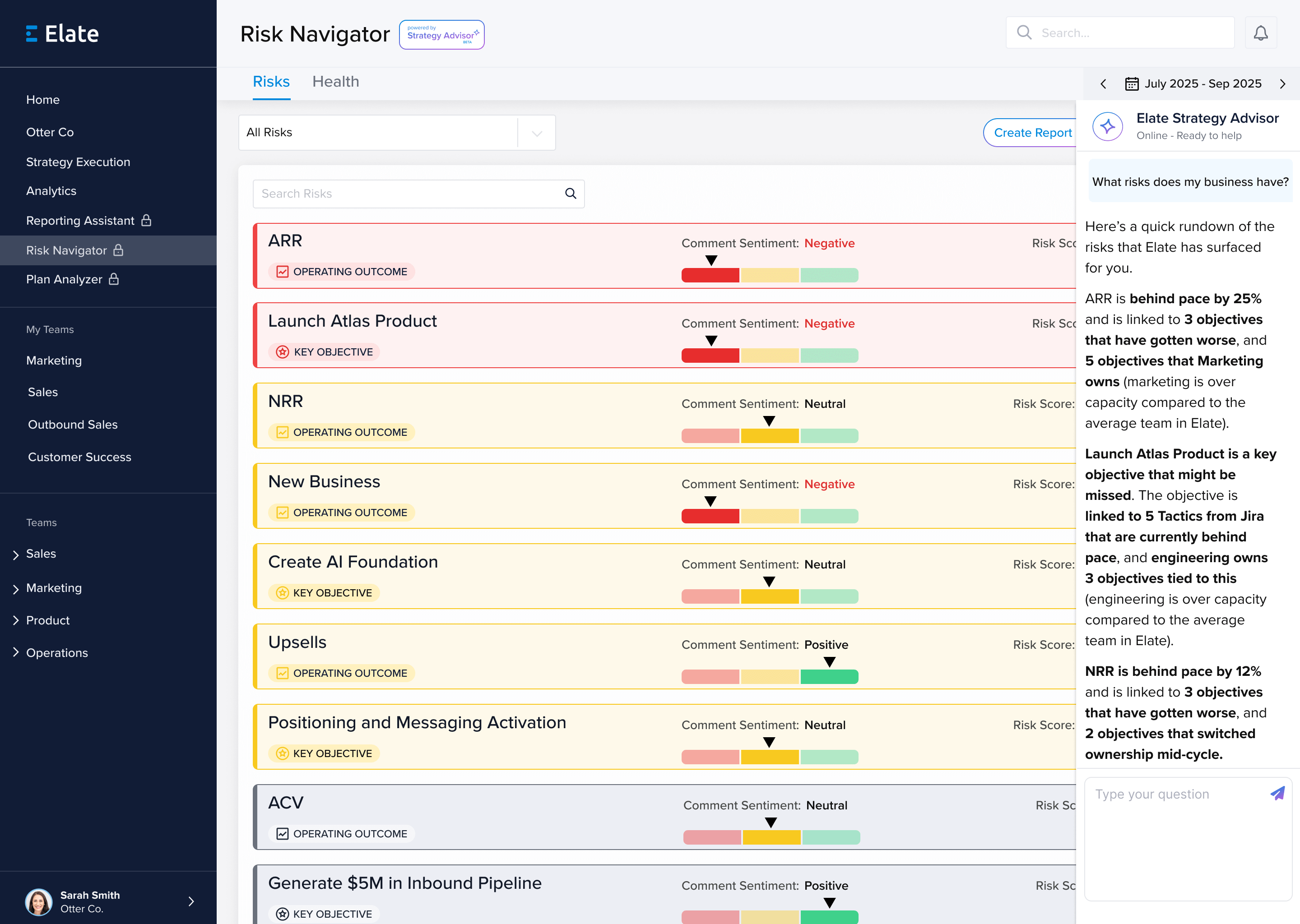Whether you're working on a small project by yourself or a big project with a full team, you're generally going to meet your goals more quickly, more efficiently, and more effectively if you have some sort of framework in place to keep the project on track.
There are countless frameworks available for this, from a simple to-do list to more sophisticated performance management tools like the balanced scorecard system or OKRs (OKR meaning Objective and Key Results).
Selecting a framework can be a challenge in itself. So let's assume that your project extends beyond the scope of a checklist of tasks, and compare OKRs vs Balanced Scorecard.
A balanced scorecard is focused on an organization's strategic agenda with a set of measurements to monitor the group's performance. The original balanced scorecard example was divided into four perspectives, being financial, customer, internal process, and learning & growth. Along with this you have a set of initiatives meant to boost performance.
OKRs are more streamlined. You start with a clearly defined goal (hence, O, for Objective), and you have a few Key Results to measure progress and achievement.
It should be clear from these descriptions alone that an OKR is more direct than a balanced scorecard approach.
The key benefit of this to-the-point approach is focus. With a balanced scorecard, it's very easy to get lost in some of the more abstract features of the model. An OKR achieves the same end as a balanced scorecard, but stripped down to a fairly simple set of features: here's what we need to do, here's how we're getting it done.
A balanced scorecard can be useful, but an OKR puts the emphasis on concrete, actionable tasks and goals. The broader vision of the project can then be outlined in mission statement and overall strategy, while the OKR simply serves the purpose of keeping everybody focused on the same goal.
Section 2 (200 words)
OKR Scorecard
To better understand the OKR scorecard, we can compare it to a KPI scorecard template.
KPI stands for Key Performance Indicators, and if the OKR framework is a streamlined version of a balanced scorecard template, then you could say that the KPI format is a streamlined OKR.
The Key Performance Indicators in a KPI structure will be goals like, for instance, zero customer complaints. Generally these are going to be general performance concerns, things that you will be doing month after month, rather than one-time goals like meeting deadlines for product launches and so on.
In contrast to OKR, KPI scorecards are an excellent tool for keeping a team focused on good habits, but the OKR framework offers a little more flexibility in the goals you're setting and how you're measuring performance.
All three models have their own use. KPI is fine for meeting the repeated daily, weekly and monthly goals that we need to meet in order to run an organization, but lacks the flexibility of OKR. Balanced scorecards are good for laying out broader plans, but not as effective as an OKR for setting precise, concrete, clearly-defined goals.
OKR Scorecard Template
There are a number of different approaches to designing an OKR scorecard template, and it's all about finding the one that works for you. But generally the information included will cover the following:
- Short and long-term company goals and missions.
- A list of goals, OKR milestones and key results.
- "Supports," being resources and strengths you can draw on, and obstacles, what's standing the way of your success.
Many users consider the OKR format to be an evolved version of the balanced scorecard, begging the question: is balanced scorecard still relevant?
You could say that balanced scorecards still have their place in management, but that place has certainly been diminished by OKR scorecards. The business world moves faster than ever these days, and for many companies and organizations, the traditional balanced scorecard is just a little too unwieldy, too complicated, too abstract and too slow.
OKR scorecards can be read at a glance. Assuming you have a well-designed, clearly laid-out template to work with, anyone on the team can take one quick look at the scorecard and know exactly how close they are to meeting their goals, and what they can do to close the gap. Balanced scorecards can't do that.
What Are The KPI Based Scorecards?
The quickest way to lay out the difference between OKR vs KPI is to cover an example of both. So let's start with an example OKR.
Objective: Create a car with a 30% reduced carbon footprint.
- Key result 1: Hire an EPA liaison to work hand-in-hand with the Environmental Protection Agency
- Key result 2: Convert manufacturing plant to solar energy
- Key result 3: Plant 100 acres of trees
Now, what are the kpi based scorecards? For an example, let's say you're operating a food truck in Austin, Texas. So you'd have a list of performance measurements that might look like this:
- Weekly sales
- Repeat business
- Membership card sign-ups
If you're deciding between these two formats, KPI is a great model when you're just starting out or if you run a small local business and you're focused on slow growth right now. OKR is focused on big growth, dramatic changes, and securing a strong foothold in your industry.
With that in mind, OKR and ROI (Return on Investment) work hand in hand. With OKR vs ROI, OKR works as a predictor of success, and ROI works as a final accounting of success. OKRs are often focused on ambitious goals, while ROI will tell you if you're getting back what you're putting into it.
OKR Examples Marketing
If you're looking for OKR examples marketing is a great area to start. If your objective is 50% higher customer engagement, well, the fastest and most efficient way to get there is usually through marketing. You can make improvements to the store or the product, but if people don't know about it, they won't bother showing up to find out.
A marketing-oriented company OKR template for, say, a sporting goods store, might cover the following Objective and Key Results.
Objective: Improve sales by 40% at Kansas City, MO location
- Key result 1: Hire SEO specialist to write specifically for the Kansas City market
- Key result 2: Sign endorsement deal with Kansas City-based athlete
- Key result 3: Sponsor a local youth athletics organization
To that you would add the resources you can draw upon, the obstacles that might stand in your way, the timeline for your key results and objective, and any broader goals your organization may be working toward.
Of course, you don't write an OKR in a vacuum, randomly guessing at goals and key results. You're writing an OKR based on market research and hard data that will help you to determine what you need to do, and predict what is most likely to help you achieve that goal.
OKR Scoring
Typically, OKR scoring is yes/no, 0.0 to 1.0. KPIs are a little softer in that regard. You're aiming for 100% customer satisfaction, but if you only get to 90%, that's fine.
With an OKR scoring template you're just looking at whether or not a goal was achieved. If one of your key results is signing an endorsement deal with a local athlete, there's no 50% success rate at that. You either sign a deal within the proposed timeline, or you don't.
This can help you to determine what framework is going to work best for you. If you have an ambitious goal that can be achieved through do-or-don't key results, then an OKR format is ideal. If you're thinking about day-to-day goals, if you're working towards a "tipping point," then a KPI can be very useful.
Personal OKR Template
There's no one-size-fits-all approach to designing an OKR template. You may find that you can't find a template that perfectly matches your needs, and you'll want to find one that's close enough, and then tweak it to suit your purposes.
No two organizations are exactly alike, so developing a personal OKR template may wind up being a matter of trial and error as you figure out what does and doesn't work for you, what your team responds to, and what helps you to better meet your goals.
This is especially true if you're using an OKR to track your own personal professional development. In this case, professional development OKR examples may look nothing like the OKR templates used to track success at an organizational level.
OKR is effectively a concept, first and foremost. You have an Objective, and a list of Key Results. And you can adapt that to whatever shape you need it to take in order to meet your own personal needs.
A personal professional development OKR for instance might look like this:
Objective: Get promoted to lead developer at software company.
- Key result 1: Learn Python and C++
- Key result 2: Attain associate's degree in software engineering
- Key result 3: Apply for a promotion
The basic idea of what an OKR looks like is the same no matter the objective you're after, but the template and the contents of the OKR will change based on the goals.
Need And Application Of KPI Based Scorecards
Considering the balanced scorecard vs KPI approach, the two really couldn't be more different. An OKR shares features of both, but a balanced scorecard is about big goals, mission statements and overall organizational strategy. A KPI is about the smaller details of managing an organization.
If you want to fully understand the need and application of KPI based scorecards, you'd do well to read Malcolm Gladwell's The Tipping Point: How Little Thing Can Make A Big Difference. In outline, the idea is simply that we succeed in the long term by focusing on the short term.
To put it one way, KPI scorecards are focused on running a tight ship. A balanced scorecard can cover increasing business through big marketing pushes and mission statements. A KPI will guide an organization on the more specific details that have a cumulative effect. If you keep the bathrooms clean, if you keep the shelves looking tidy, if you hire friendly staff and promote only the most qualified people, you will eventually see results.
To lay out these three approaches: KPI is focused on the smaller, repeated goals, OKR is focused on broader objectives and initiatives, and Balanced Scorecards are looking at the big picture, the mission statement, the long term goals and so on.
Determining which one is right for your organization all come down to the scale and scope of your goals at the present moment.











